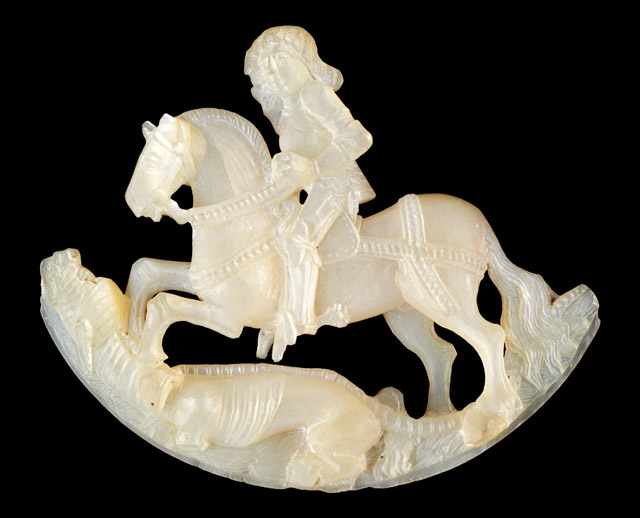Appliqué with Saint George Slaying the Dragon
The Walters Art Museum, Baltimore

 Select the image to zoom
Select the image to zoom
This fragment is all that remains of a circular relief that was once attached to a pax, a tablet with a sacred image kissed by the celebrant and the faithful during Mass. The pax was in the collection of liturgical vessels and reliquaries established in Halle, Germany, by Cardinal Albrecht of Brandenburg (r. 1490–1545), archbishop of Mainz and an important patron of the arts. In addition to extensive building campaigns to remodel the collegiate church at Halle, his primary residence, and the cathedral in Mainz, Albert collected an impressive number of relics housed in precious reliquaries. Once a year the reliquaries were exhibited to the public in organized "rounds." Those who saw the collection, known as the Hallesches Heiltum (the sacred objects of Halle), gained numerous indulgences, and thus the cardinal's collection at Halle became an important site of pilgrimage. In 1520, Albrecht had each of his reliquaries illustrated in a printed book that served as a guide to the pilgrims but also as memory of the event to be used for further meditation. Later, his collection was the subject of a lavish hand-painted book. One of the pages of this book shows the pax before its destruction with the mother-of-pearl relief of St. George killing the dragon. Originally, a princess appeared on the right side of the relief and is now lost as well as the saint's right arm wielding the sword. The damage might have occurred during the tumultuous events that followed the Reformation. However, Cardinal Albrecht's collection was dispersed during his own lifetime, as he sold or pawned his precious reliquaries to raise capital.
The luminescence of mother of pearl is evident in this delicate appliqué carving. Mother of pearl is very brittle and hard and it is difficult to carve. Only the flat central portion of a shell can be used for figurative reliefs such as this one. The medium became popular during the sixteenth century as a decorative element in liturgical furnishings, probably as a result of the availability of large shells from tropical seas.




